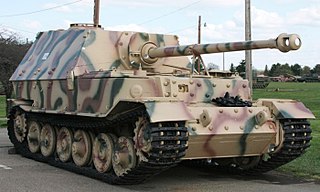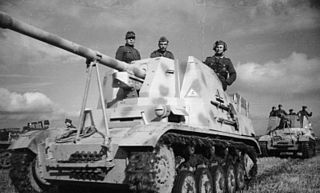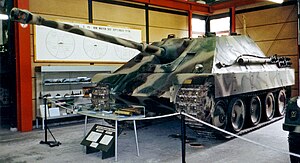
The Panzerkampfwagen IV, commonly known as the Panzer IV, is a German medium tank developed in the late 1930s and used extensively during the Second World War. Its ordnance inventory designation was Sd.Kfz. 161.

This article lists production figures for German armored fighting vehicles during the World War II era. Vehicles include tanks, self-propelled artillery, assault guns and tank destroyers.

The Panzerkampfwagen 38(t), originally known as the ČKD LT vz. 38, was a tank designed during the 1930s, which saw extensive service during World War II. Developed in Czechoslovakia by ČKD, the type was adopted by Nazi Germany following the annexation of Czechoslovakia. With the German Army and other Axis forces, the type saw service in the invasions of Poland, France and the USSR. Production ended in 1942, when its main armament was deemed inadequate. In all, over 1,400 Pz. 38(t)s were manufactured. The chassis of the Pz. 38(t) continued to be produced for the Marder III (1942–1944) with some of its components used in the later Jagdpanzer 38 (1944–1945) tank destroyer and its derivative vehicles.

The Jagdpanzer 38, originally the Leichter Panzerjäger 38(t), known mostly post-war as Hetzer, was a German light tank destroyer of the Second World War based on a modified Czechoslovakian Panzer 38(t) chassis.

The Panther tank, officially Panzerkampfwagen V Panther with ordnance inventory designation: Sd.Kfz. 171, is a German medium tank of World War II. It was used on the Eastern and Western Fronts from mid-1943 to the end of the war in May 1945.

The Jagdtiger is a German casemate-type heavy tank destroyer (Jagdpanzer) of World War II. It was built upon the slightly lengthened chassis of a Tiger II. Its ordnance inventory designation was Sd.Kfz. 186.

Elefant was a heavy tank destroyer used by German Panzerjäger during World War II. Ninety-one units were built in 1943 under the name Ferdinand using VK 45.01 (P) tank hulls which had been produced for the Tiger I tank before the competing Henschel design had been selected.

The Sturmgeschütz III was an assault gun produced by Germany during World War II. It was the most-produced fully tracked armoured fighting vehicle, and second-most produced German armored combat vehicle of any type after the Sd.Kfz. 251 half-track. It was built on a slightly modified Panzer III chassis, replacing the turret with an armored, fixed superstructure mounting a more powerful gun. Initially intended as a mobile assault gun for direct-fire support for infantry, the StuG III was continually modified, and much like the later Jagdpanzer vehicles, was employed as a tank destroyer.

Marder III was the name for a series of World War II German tank destroyers. They mounted either the modified ex-Soviet 76.2 mm F-22 Model 1936 divisional field gun, or the German 7.5 cm PaK 40, in an open-topped fighting compartment on top of the chassis of the Czechoslovakian Panzer 38(t). They offered little protection to the crew, but added significant firepower compared to contemporary German tanks. They were in production from 1942 to 1944, and served on all fronts until the end of the war, along with the similar Marder II. The German word Marder means "marten" in English.

Nashorn, initially known as Hornisse, was a German Panzerjäger of World War II. It was developed as an interim solution in 1942 by equipping a light turretless chassis based on the Panzer III and Panzer IV tanks with the 8.8 cm Pak 43 anti-tank gun. Though only lightly armoured and displaying a high profile, it could penetrate the front armour of any Allied tank at long range, and its relatively low cost and superior mobility to heavier vehicles ensured it remained in production until the war's end.

The Marder II was a German tank destroyer of World War II based on the Panzer II chassis. There were two versions, the first mounted a modified Soviet 7.62 cm gun firing German ammunition, while the other mounted the German 7.5 cm Pak 40 gun. Its high profile and thin open-topped armor provided minimal protection to the crew. Nevertheless, the Marder II provided a great increase in firepower over contemporary German tanks during 1942 and into 1943. Only four Marder IIs remain today.

Panzerjäger is a term used for an anti-tank vehicle, as well as anti-tank units. The term was first used in the Wehrmacht, and also post-war by the German Federal Republic Bundeswehr. The term Panzerjäger was used in the Bundeswehr as a designation of rank.

The Sturmgeschütz IV was a German assault gun variant of the Panzer IV used in the latter part of the Second World War. It was identical in role and concept to the highly successful StuG III assault gun variant of the Panzer III. Both StuG models were given an exclusively tank destroyer role in German formations and tactical planning in the last two years of the war, greatly augmenting the capability of the dwindling tank force available to the German army on the Eastern and Western fronts.

The Jagdpanzer IV, Sd.Kfz. 162, was a German tank destroyer based on the Panzer IV chassis and built in three main variants. As one of the casemate-style turretless Jagdpanzer designs, it was developed against the wishes of Heinz Guderian, the inspector general of the Panzertruppen, as a replacement for the Sturmgeschütz III. Guderian objected against the needless, in his eyes, diversion of resources from Panzer IV tank production, as the StuG III was still more than adequate for its role.

The 15 cm sIG 33 (Sf) auf Panzerkampfwagen 38(t), also known as Grille was a series of self-propelled artillery vehicles used by Nazi Germany during World War II. The Grille series was based on the Czech Panzer 38(t) tank chassis and used a 15 cm sIG 33 infantry gun.
The Panzerkampfwagen I was a light tank produced in Germany in the 1930s. The Panzer I was built in several variants and was the basis for a number of variants listed below.




















